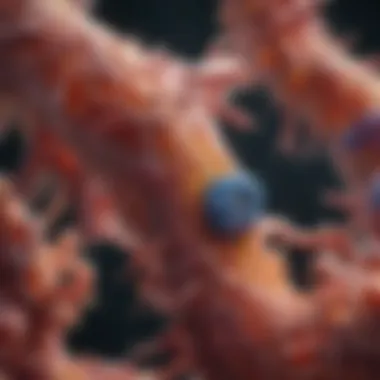Understanding Stomach Cancer Metastasis


Intro
Stomach cancer, also known as gastric cancer, is a significant health concern worldwide. It presents unique challenges, particularly in its metastatic form—when cancer cells spread beyond the stomach to other parts of the body. In this exploration, we’ll dig deep into the mechanisms of stomach cancer metastasis, shedding light on its complexities, the clinical implications, and ways to manage it effectively. By dissecting these matters, we aim to enhance understanding, especially in the medical community and among researchers.
Understanding the journey of metastasis begins with identifying key patterns and behaviors of cancer cells. Unlike well-behaved cells that typically stick to their designated roles, cancer cells can become like restless wanderers, breaking free from their origin and infiltrating other tissues. In this context, we will cover vital aspects—ranging from biological mechanisms, early detection techniques, to the latest therapeutic approaches. By focusing on these topics, we hope to provide insights that can guide future research and treatment methods.
Key Findings
Major Results
The investigation into stomach cancer metastasis has uncovered several key findings. Research has shown that:
- Markers of Aggression: Specific biomarkers, such as CD44 and MMPs, are indicators of a more aggressive disease and metastasis.
- Influence of Microenvironment: The tumor microenvironment plays a crucial role in the metastatic process, as it can either promote or hinder the migration of cancer cells.
- Role of Lymphatic System: Stomach cancer commonly spreads through the lymphatic system, highlighting the importance of understanding lymphangiogenesis in treatment planning.
These findings suggest that tailored treatment strategies are essential, taking into account individual patient profiles and tumor characteristics.
Discussion of Findings
Discussing these findings necessitates considering the factors at play in metastasis. For darstic example, patients who exhibit certain genetic profiles may respond vastly different to treatments. This variability emphasizes the need for personalized medicine in combating stomach cancer.
"The clinic's most promising approach remains debatable, but expanding the parameters of gene testing and imaging technology showcases a way forward."
Additionally, researchers are scrutinizing new treatment modalities, such as immunotherapy and targeted therapies, that offer hope in reversing or managing metastasis. These treatments often rely on a clear understanding of the molecular pathways involved, pointing to the need for ongoing research.
Methodology
Research Design
The research surrounding stomach cancer metastasis employs various methodologies, often encompassing both laboratory experiments and clinical studies. Many studies incorporate longitudinal designs, allowing researchers to observe the behavior of metastatic cells over time within diverse populations.
Data Collection Methods
Key data is typically collected through:
- Biopsy Samples: Analyzing tissue to understand cellular behavior and mutations.
- Advanced Imaging Techniques: Techniques like PET scans or MRI help visualize spread.
- Patient Surveys: Gathering self-reported data on symptoms and responses to treatment.
This multi-faceted approach allows us to paint a clearer picture of how metastasis unfolds, leading to better management strategies and patient outcomes.
As we delve deeper into the world of stomach cancer metastasis, understanding these findings and methodologies becomes paramount. By recognizing how this disease spreads and identifying effective management strategies, stakeholders from various fields can converge to make significant strides in patient care and research.
Foreword to Stomach Cancer Metastasis
Stomach cancer metastasis is a crucial topic within the broader conversation of oncology, particularly regarding its intricate nature and the implications for patient outcomes. Understanding how stomach cancer spreads is vital not just for clinicians, but also for researchers and care providers. This section unpacks the core principles and underlying factors that contribute to metastasis, aiming to shed light on an area that can often be overlooked.
Metastasis refers to the process by which cancer cells move from their original tumor site to other parts of the body, forming new tumors. This biological phenomenon is a major player in determining prognosis and treatment strategies. It's the difference between a cancer that can potentially be cured and one that becomes more challenging to manage once it has spread.
Definition and Overview
Stomach cancer, or gastric cancer, arises from the lining of the stomach and can manifest in various forms. When we talk about metastasis in this context, we're considering how these malignant cells exit their primary location and infiltrate surrounding tissues or travel to distant organs. A clear understanding of this process is paramount not only for the treatment but also for improving overall patient quality of life.
The metastatic journey typically occurs through different routes:
- Direct extension: Cancer cells invade nearby tissues.
- Lymphatic spread: Tumor cells utilize the lymphatic system to reach lymph nodes.
- Hematogenous spread: Cells migrate through the bloodstream to distant sites.
This understanding provides a framework for developing intervention strategies that can address not just the primary tumor but also any secondary sites where the cancer may emerge.
Epidemiology of Stomach Cancer
The epidemiological landscape of stomach cancer serves as a foundation for grasping its metastatic pathways. Globally, it ranks as the fifth most prevalent cancer, yet it proves lethal, often showing high mortality rates.
Research indicates several risk factors, including dietary habits, genetic predisposition, and chronic infection with Helicobacter pylori, all contributing to both the incidence and progression of the disease.
"Being aware of the regional variations helps to tailor preventive strategies, especially in high-incidence areas."
According to the World Health Organization, the five-year survival rate for stomach cancer varies significantly across different populations, influenced by various cultural and socioeconomic factors. For instance, in Asia, rates tend to be higher, largely attributed to diets high in salt and nitrites, while Western countries are witnessing shifts due to improved screening and detection methods.
In summary, a nuanced view of the epidemiology of stomach cancer allows for a deeper appreciation of how environmental and genetic factors collaborate in the intricacies of metastasis. This section ultimately establishes a vital context for understanding the subsequent sections on biological mechanisms and clinical implications.
Biological Mechanisms of Metastasis
Understanding the biological mechanisms behind metastasis is key to tackling stomach cancer, especially considering the complexities involved. When cancer cells choose to migrate and invade tissues beyond their origin, it transforms the treatment landscape and poses significant challenges for patient management. Comprehending these processes not only influences therapeutic strategies but also underscores the critical need for early detection of metastatic disease.
Cellular and Molecular Basis
At the core of metastasis lies an intricate dance of cellular and molecular interactions. This process begins when tumor cells undergo changes that enable them to detach from the primary site. A notable element here is the epithelial-mesenchymal transition (EMT), wherein epithelial cells lose their characteristics and gain migratory properties. This transition is often fueled by molecular signals and microenvironmental cues that prompt cancer cells to become more mobile.
Once these cells are in circulation, they need to survive various obstacles, including shear stress from blood flow and immune surveillance. Here, circulating tumor cells (CTCs) play a pivotal role, as they can disseminate throughout the body. Not only do these cells need to navigate through the bloodstream, but they also undergo apoptosis, which is the programmed cell death process, if not adequately preserved.
Upon reaching distant sites, tumor cells must then re-establish themselves and colonize new environments. The process involves various mechanisms, such as extravasation, where cancer cells exit the bloodstream and infiltrate surrounding tissues. The success of this colonization largely hinges on the tumor's ability to adapt to the new microenvironment, a capacity influenced by the genetic alterations that have accumulated throughout tumor progression.
"The evolution of cancer cells, from local to systemic disease, is a formidable journey requiring both genetic and environmental adaptations."


Role of Tumor Microenvironment
The tumor microenvironment is a crucial player in the metastatic process. This includes not just the cancer cells, but also the myriad of other components like stromal cells, immune cells, and extracellular matrix (ECM). Together, these elements forge an environment that can either inhibit or promote the invasive behavior of cancer.
Stromal cells, such as fibroblasts and endothelial cells, interact with tumor cells and contribute to a supportive niche. For instance, cancer-associated fibroblasts (CAFs) can secrete growth factors and cytokines that facilitate tumor progression and transformation. Additionally, the ECM can provide a scaffold that helps cancer cells to anchor and proliferate within secondary sites.
Immune cells, paradoxically, can either thwart or assist cancer metastasis. For example, certain immune cell types may exhibit an anti-tumor effect by targeting malignant cells, while others, like myeloid-derived suppressor cells (MDSCs), may enhance tumor spread by suppressing the immune response.
Thus, the interplay between cancer cells and the tumor microenvironment is intricate. Understanding these variations sheds light on potential therapeutic interventions that could disrupt these supportive networks, thereby hindering the metastatic process. More detailed exploration of these cellular and molecular dynamics can reveal crucial insights for developing effective treatment strategies.
Common Sites of Metastasis
The exploration of the common sites of metastasis in stomach cancer is crucial as it shapes the approach to diagnosis, treatment, and patient management. Understanding where this aggressive cancer tends to spread not only helps in predicting outcomes but also guides clinicians in ameliorating symptoms, tailoring treatment options, and ultimately improving patient survival rates. Primarily, stomach cancer is notorious for its ability to spread beyond the gastrointestinal tract, affecting various organ systems and presenting a plethora of clinical challenges.
Regional Lymph Nodes
Regional lymph nodes serve as the first line during the metastatic dance. For stomach cancer, lymphatic spread is primarily through the gastric lymph nodes, which are closely associated with the stomach. When the cancer breaches the confines of the gastric lining, it can infiltrate these lymph nodes, which often act as staging markers indicating how advanced the disease is.
The significance of regional lymph node metastasis cannot be overstated. The involvement of these nodes is not only a predictor of prognosis but also a pivotal factor influencing treatment decisions. For instance, if cancer is found in the lymph nodes, doctors may intensify the treatment strategy, considering aggressive interventions like chemotherapy or radiation therapies in conjunction with surgical approaches.
- Commonly Affected Lymph Node Areas:
- Perigastric nodes
- Celiac nodes
- Gastroepiploic nodes
A comprehensive evaluation of the lymphatic system through imaging techniques like CT scans or PET scans is essential for assessing nodal involvement. This, in itself, is a core consideration for oncologists in staging the cancer, which can significantly affect patient management plans.
Distant Organs and Tissues
Stomach cancer is merciless in its ability to migrate to distant organs. The liver, lungs, peritoneum, and bones are often the unfortunate recipients of metastases. The liver, in particular, is frequently involved due to its proximity to the stomach and its rich blood supply. Patients may experience symptoms like jaundice or abdominal pain when the liver is engaged, which complicates their clinical picture further.
Other organs, such as the lungs, when affected, may lead to respiratory distress or pleural effusions, while peritoneal involvement can manifest as ascites, painting a grim picture.
Key Points on Distant Organ Involvement:
- Liver Metastases: Most common, leading to hepatic dysfunction and symptoms.
- Lung Metastases: Often subtle, initially may present as a chronic cough or difficulty breathing.
- Peritoneal Carcinomatosis: May be indicated by fluid in the abdomen, requiring effective symptom management.
Patterns of Spread
Understanding the patterns of spread in metastatic stomach cancer not only illuminates the complex nature of its progression but also serves as a guide for clinicians during treatment planning.
The dissemination can occur through various mechanisms:
- Direct Extension: Tumors may grow directly into adjacent structures, which is significantly noted in advanced stages of cancer.
- Lymphatic Spread: As previously discussed, this pathway often leads to regional lymph nodes before further dissemination.
- Hematogenous Spread: Through the bloodstream, cancer cells can invade distant organs.
- Transcoelomic Spread: Cancer cells can spread across the peritoneal cavity, known as peritoneal carcinomatosis, leading to significant complications.
"A thorough understanding of metastasis patterns provides insight into how best to tackle this complex disease, tailoring specific treatments based on the patterns noted for each individual patient."
In summary, the common sites of metastasis in stomach cancer play a vital role in shaping clinical outcomes, guiding diagnostic approaches, and influencing treatment decisions. As research continues to evolve, understanding these patterns can be pivotal in improving prognostic factors and ultimately patient-centered care.
Clinical Manifestations of Metastatic Stomach Cancer
Understanding the clinical manifestations of metastatic stomach cancer is crucial in recognizing how the disease progresses and impacts patients. The symptoms and signs associated with metastasis can significantly affect both the quality of life and overall prognosis. It's essential for healthcare professionals and caregivers to identify these manifestations early so appropriate interventions can be made. This section will shed light on the common symptoms and the diagnostic challenges that arise when dealing with such a complex condition.
Symptoms and Signs
The symptoms related to metastatic stomach cancer depend on where the cancer has spread, and they can vary widely among patients. However, several symptoms can serve as potential red flags, signaling the presence of metastasis. Here are some notable ones:
- Abdominal Pain: Patients may experience discomfort or pain in the abdomen, often linked to tumor growth or fluid accumulation.
- Unexplained Weight Loss: A significant and often unexplained reduction in weight can be indicative of the body reacting to the cancer.
- Nausea and Vomiting: These symptoms can arise due to obstruction caused by the tumor or as a side effect of the body's fight against cancer.
- Dysphagia: Difficulty swallowing is common, particularly if the cancer has spread to areas that affect swallowing.
- Fatigue: Ongoing tiredness may result from the body’s resources being depleted by the cancer.
- Jaundice: Yellowing of the skin or eyes may occur if cancer spreads to the liver, impacting its function.
Symptoms of metastasis can often resemble other conditions, making early recognition a challenging but vital aspect of effective management.
Each of these symptoms should raise awareness for possible metastatic disease. Monitoring patients who exhibit these signs is essential for timely diagnosis and intervention.
Diagnostic Challenges
Diagnosing metastatic stomach cancer poses a unique set of challenges. Given the nonspecific nature of many symptoms, traditional diagnostic methods might miss the mark. Some diagnostic hurdles include:
- Overlapping Symptoms: Symptoms can overlap with benign conditions, leading to misdiagnosis or delayed diagnosis. For instance, weight loss and fatigue can also be signs of gastrointestinal disorders not related to cancer.
- Limited Diagnostic Tests: Not every patient is subjected to advanced imaging techniques or endoscopies early in their medical journey, which can delay the identification of metastasis.
- Personal Variability: Each patient's presentation can differ significantly, making it hard to establish a one-size-fits-all approach to diagnosis.
Connecting the dots requires not just the expertise of specialists but also the incorporation of both clinical and historical patient data. This increasing complexity highlights the need for ongoing education and research into better diagnostic protocols for metastatic stomach cancer.
Diagnosis and Staging
The journey through stomach cancer metastasis is complex and fraught with challenges. Proper diagnosis and staging are pivotal in understanding the extent of the disease and determining the optimal pathway for treatment. Without these critical steps, clinicians are left navigating in the dark, potentially leading to suboptimal outcomes for patients. Staging, in particular, categorizes how far the cancer has spread, which is crucial for selecting treatment options and forecasting prognosis.
In the context of metastatic stomach cancer, accurate diagnosis and staging can shed light on many facets:
- Tailored Treatment Plans: With precise information about the cancer's spread, healthcare professionals can customize treatment strategies to better suit the individual patient’s situation.
- Prognostic Evaluation: Staging helps in understanding the expected disease progression and the possible outcomes for the patient. This understanding allows families and caregivers to prepare accordingly.
- Resource Allocation: Knowing whether a patient falls into a higher category of metastasis can help allocate resources appropriately within healthcare systems, optimizing care delivery.
Each of these elements underlines the fundamental role of diagnosis and staging in managing stomach cancer.
Imaging Techniques


Imaging techniques serve as the first line of defense in diagnosing stomach cancer and assessing its progression. These tools allow doctors to visualize internal structures and identify any anomalies. Most commonly utilized imaging approaches include:
- Computed Tomography (CT) Scans: This is one of the most common imaging modalities, giving a detailed look at the abdomen, which is essential for spotting tumors and determining spread to lymph nodes or other organs.
- Magnetic Resonance Imaging (MRI): While not as frequently used as CT, MRI can offer valuable insights, particularly in evaluating soft tissues, which may reveal subtle changes in cancerous growths.
- Endoscopic Ultrasound (EUS): This involves an endoscope that combines ultrasound technology to obtain images of the stomach wall and surrounding structures, providing critical information on local invasion.
- Positron Emission Tomography (PET) Scans: These are vital for detecting cancerous cells, as they help visualize areas of increased metabolic activity, a hallmark of malignancy.
Each of these imaging techniques brings its own strengths and can be chosen based on the individual patient situation. In using these tools judiciously, oncologists can map out a more effective battle plan against the disease.
Biopsy and Pathological Assessment
A definitive diagnosis often relies on biopsy and subsequent pathological assessment. This process involves taking a small sample of tissue from the stomach to determine the presence of cancerous cells. Understanding this methodology is vital. Here’s why:
- Tissue Diagnosis: Biopsies provide a clear picture of the cellular makeup, helping to ascertain whether the tumors are benign or malignant. This distinction is fundamental for determining the appropriate treatment.
- Molecular Profiling: Beyond simple diagnosis, advanced techniques allow for molecular profiling of the tumor, unveiling potential genetic mutations that could influence treatment options.
- Response to Treatment: By analyzing the biopsy, doctors can predict likely responses to specific therapies, tailoring the approach for maximum effectiveness.
Effective biopsy techniques, whether through endoscopy or imaging guidance, combined with thorough pathological evaluation, can greatly enhance the diagnostic accuracy and treatment planning for stomach cancer patients.
Staging Systems and Their Importance
Staging systems are essential frameworks that categorize cancer based on specific criteria, such as tumor size, lymph node involvement, and presence of metastasis. The most widely adopted classification is the TNM system, which equips healthcare providers with a standardized means to assess and communicate cancer severity. Here’s what each component signifies:
- T (Tumor): Measures the size of the primary tumor and how deeply it has invaded the stomach walls.
- N (Node): Evaluates whether regional lymph nodes are involved.
- M (Metastasis): Indicates if cancer has spread to distant sites, crucial for treatment strategies.
The importance of staging cannot be overstated:
- Guides Treatment Choices: Based on staging, oncologists can decide between surgery, chemotherapy, or radiation, optimizing treatment plans to combat the disease effectively.
- Helps in Clinical Trials: Proper staging ensures patients are accurately assigned to clinical trials, which can offer access to cutting-edge treatments.
- Supports Research Development: Understanding patterns in staging and patient profiles aids researchers in developing more targeted therapies.
Ultimately, a meticulous approach to staging offers clarity to patients, families, and clinicians, fostering a shared understanding and a proactive stance against metastasis in stomach cancer.
Prognostic Factors in Metastatic Stomach Cancer
Understanding the prognostic factors associated with metastatic stomach cancer is crucial for shaping treatment strategies and improving patient outcomes. By examining specific elements that influence patient prognosis, healthcare providers can tailor interventions more effectively. Moreover, this knowledge helps in predicting disease progression, which can significantly affect clinical decisions.
Tumor Characteristics
The characteristics of the tumor itself are pivotal in determining the prognosis of patients with metastatic stomach cancer. Various features can give essential insight into the potential aggressiveness of the cancer and its likelihood of metastasizing further.
- Histological Type: The type of gastric cancer plays a significant role. For instance, poorly differentiated tumors tend to progress more rapidly compared to well-differentiated types. Differentiation level can often predict the response to treatment and overall survival.
- Tumor Size and Location: Larger tumors often indicate more advanced disease. Similarly, involvement of certain anatomical regions can affect spread patterns and complicate surgical options.
- Molecular Markers: Various markers such as HER2 and PD-L1 presence can guide therapy choices and provide information about prognosis. Understanding these markers can unveil the potential effectiveness of targeted therapies.
- Stage of the Disease: The extent and stage of stomach cancer at diagnosis are critical in prognostication. More advanced stages correlate with poorer prognoses and require more aggressive treatment approaches.
These tumor characteristics, when analyzed in conjunction with other factors, create a clearer picture of individual patient outcomes. For instance, researchers have found that certain combinations of histological types and molecular markers can dramatically alter survival rates.
"In cancer treatment, one size does not fit all. Understanding tumor characteristics is like having a map in unfamiliar territory. It guides the way forward."
Patient-Related Factors
Apart from tumor characteristics, patient-related factors also significantly affect prognosis. These encompass a variety of elements ranging from demographic details to overall health and lifestyle choices.
- Age and Gender: Studies imply that younger patients often have a better prognosis than older ones. Moreover, differences in survival rates between genders can also be observed, with males generally exhibiting poorer outcomes.
- Comorbidities: Patients with other health conditions such as diabetes or cardiovascular diseases may face challenges in treatment tolerability, which could hinder the effectiveness of cancer therapies and ultimately impact survival rates.
- Nutritional Status: Malnutrition can severely compromise treatment effectiveness. Adequate nutrition is vital for recovery and resilience against the rigors of cancer therapy.
- Psychosocial Factors: Emotional and mental health factors shouldn't be overlooked. Support systems, mental well-being, and coping strategies can influence treatment adherence and general health outcomes.
Understanding these patient-related prognostic factors not only aids clinical decision-making but also highlights the importance of a holistic approach in cancer care.
Acknowledging that each patient's response to treatment can differ greatly enhances the ability to implement personalized medical strategies, ultimately improving quality of life and survival outcomes.
Treatment Options for Stomach Cancer Mets
Navigating treatment options for stomach cancer metastasis is a pivotal aspect of managing the disease. Understanding these options, tailored to each patient’s specific circumstances, plays a critical role in improving outcomes and enhancing quality of life. Often, this multi-faceted approach encompasses various treatment modalities, each aiming to address not just the physical illness but also the emotional and psychological burdens that accompany such a diagnosis. Decisions around treatment options should be made collaboratively among patients, oncologists, and healthcare teams to prioritize effectiveness while considering individual preferences and health status.
Surgical Interventions
Surgical options may be viable, particularly if metastasis is localized or if primary tumors remain operable. The type of surgery can vary, ranging from partial resection, which involves removing a portion of the stomach along with the tumor, to more extensive procedures like total gastrectomy, where the entire stomach is excised. Additionally, surgeries might be done to alleviate symptoms caused by blockages or bleeding, creating a direct path to relieve discomfort.
- Rationale for Surgery:
- Surgical interventions can mitigate symptoms such as pain and obstruction, enhancing the patient’s quality of life.
- In some cases, surgery may provide a chance for potential cure or long-term remission.
Despite the potentials, there are several factors to weigh:
- Health Status: Is the patient healthy enough for surgery, or would the risks outweigh the possible gains?
- Location and Extent of Mets: Are metastases confined to particular areas, making them operable? The location can significantly dictate whether surgery is feasible.
Patients should discuss with their healthcare providers about what a surgical intervention could look like in thier specific case, as it is crucial to understand the implications before proceeding.
Chemotherapy Regimens
Chemotherapy remains a cornerstone in treating metastatic stomach cancer, often deployed following surgery or as a primary treatment when surgery is insufficient. The aim here is to shrink the tumors or slow their growth, acting systemically to target cancer cells throughout the body. Typically, chemotherapy regimens combine multiple drugs to maximize effectiveness.
- Common Agents:
- Fluorouracil (5-FU) or Capecitabine paired with Cisplatin or Oxaliplatin are commonly used combinations.
- Newer agents like Ramucirumab can also be incorporated depending on individual responses.
Considerations surrounding chemotherapy include:
- Side Effects: Common effects such as nausea, fatigue, and hair loss can significantly affect daily life and psychological well-being.
- Treatment Duration: Some patients may undergo months of treatment, requiring resilient mental fortitude as they navigate the demands of ongoing therapy.


The significance of regular check-ins during chemotherapy can't be understated, allowing healthcare providers to adjust treatments based on tolerance and effectiveness, fundamentally personalizing the approach.
Targeted Therapies and Immunotherapy
In recent years, targeted therapies and immunotherapy have emerged as innovative avenues in the management of metastatic stomach cancer. The primary appeal of these options lies in their ability to specifically target cancer cells or boost the body’s immune response to attack tumors, thereby potentially reducing collateral damage to normal cells.
- Examples of Targeted Therapies:
- HER2 inhibitors, like Trastuzumab, for cancers that overexpress HER2 protein.
- VEGF inhibitors, such as Bevacizumab, which aim to disrupt the blood supply to tumors.
Immunotherapy, particularly Checkpoint Inhibitors, has had notable impacts in helping the immune system recognize and combat cancer cells. Their use represents a paradigm shift towards more personalized treatment regimens. This therapy harnesses the body’s own defense mechanisms, and while it can yield profound results, it is accompanied by its own set of challenges, such as immune-related adverse effects.
As treatments continue to evolve, constant discussions and research on the effectiveness of targeted therapies and immunotherapy are necessary to keep abreast of new developments, offering patients the most effective and personalized care for their metastatic stomach cancer.
Emerging Research and Future Directions
In the realm of stomach cancer metastasis, ongoing research is pivotal. The ever-evolving landscape of cancer treatment demands a keen eye on innovative methodologies that could reshape standard practices. Emerging research not only aims to unearth new treatment avenues but also endeavors to deepen our comprehension of the disease itself. Understanding these advancements can lead to better patient outcomes and more targeted therapies, which is crucial given the complexity of stomach cancer's metastasis.
Innovative Treatment Approaches
Recent efforts in research are laying the groundwork for several innovative treatment strategies. For instance, the incorporation of liquid biopsies is revolutionizing how we detect metastasis. Instead of invasive procedures that can be uncomfortable for patients, liquid biopsies analyze circulating tumor DNA found in the bloodstream. This provides a less invasive method of monitoring cancer progression and might foster timely adjustments to treatment plans.
In another exciting development, nanotechnology is surfacing in cancer therapy discussions. Harnessing tiny particles to deliver drugs directly to tumor cells allows for higher concentrations of treatment in the affected areas with reduced side effects. This specificity is a game changer, especially when dealing with metastatic sites, which can vary in response to conventional therapies.
Furthermore, innovative methods are being explored in the realm of personalized medicine. Therapies are increasingly being tailored to target the genetic characteristics of an individual’s tumor, rather than a one-size-fits-all approach. As researchers delve deeper into genetic profiling, we may see treatments evolve that are not only more effective but also minimize potential adverse effects.
"In the fight against metastatic stomach cancer, every advance brings us closer to tailored therapies that grip the root of the issue, not just the symptoms."
Genetic and Molecular Insights
The focus on genetic and molecular insights is another frontier in stomach cancer research. Understanding the genetic mutations associated with stomach cancer can illuminate why some tumors behave aggressively while others are more indolent. For instance, alterations in genes like HER2 and EGFR have significant implications for treatment and prognosis.
Moreover, large-scale genomic studies have spotlighted biomarkers that predict response to certain therapies, allowing oncologists to choose more effective treatment plans. Genetic tests can help identify whether a tumor is likely to respond to specific drugs or indicate the need for more aggressive treatment.
In addition to discovering actionable mutations, research into the immune landscape of gastric tumors is advancing. Investigating how tumors evade immune responses can unveil new therapeutic targets. For example, understanding why certain constructs like PD-1 inhibitors may lead to variable responses paves the way for combination therapies, ultimately enhancing efficacy against resistant metastatic diseases.
As we trudge along in this fight against stomach cancer metastasis, it’s clear that these innovative treatment approaches, paired with a robust understanding of genetic influencers, will guide us toward a future where patients benefit from tailored, efficient, and less invasive options.
Patient Support and Palliative Care
Patient support and palliative care form an essential backbone in the management of metastatic stomach cancer, providing not just medical aid but a holistic approach that addresses the multifaceted challenges faced by patients and their families. As the disease progresses, patients undergo physical, emotional, and social hurdles that require a well-rounded support system. Understanding these elements is pivotal to improving their quality of life.
Psychosocial Support Systems
Psychosocial support systems play a critical role in helping patients cope with the mental and emotional burden of cancer. It's not just about medication or surgery; it’s about the mind and spirit as well. The emotional repercussions can be severe�—sadness, anxiety, and fear interweave with the physical symptoms of the disease.
These support systems may include:
- Counseling Services: Access to psychological counseling can help patients work through their feelings, fears, and uncertainties. Therapists trained in oncology can assist patients in finding a path to emotional resilience.
- Support Groups: Engaging with peers in similar situations often makes patients feel less isolated. Sharing experiences in a nurturing environment can validate their struggles and provide practical coping strategies.
- Family Involvement: Encouraging family to participate in the support network not only helps the patient but also guides family members in understanding and dealing with their own emotional responses.
Such strategies collectively work towards mitigating the stress and anxiety that often accompany cancer diagnoses, paving the way for patients to focus on healing and quality of life.
"Support systems are not merely a luxury; they are essential for effective cancer management."
End-of-life Considerations
End-of-life care is a sensitive phase in the trajectory of metastatic stomach cancer. As the disease reaches its advanced stages, discussions surrounding palliative care become increasingly important. The aim here is to ensure that patients live their final days with dignity and comfort.
Key considerations include:
- Advanced Care Planning: Encouraging discussions about patient wishes ensures that care aligns with their values and preferences. End-of-life wishes should be documented to avoid confusion later on.
- Symptom Management: Healthcare teams should prioritize alleviating discomfort—pain management, nausea control, and emotional support are vital. Using both pharmacological and complementary therapies can significantly improve the quality of life.
- Hospice Services: Transitioning to hospice care may be appropriate when curative treatment is no longer viable. This approach offers specialized support that focuses on comfort and allows patients to spend their final days surrounded by loved ones.
Navigating this phase can be challenging for both patients and their families. Essential conversations about end-of-life care not only help patients feel in control but also pave the way for a more peaceful transition.
Epilogue
In the realm of stomach cancer, comprehending metastasis is essential. This phenomenon, where cancer cells spread beyond the primary tumor, radically alters treatment approaches and patient outcomes. Understanding its intricacies not only illuminates the burdens faced by patients but also enhances the strategies employed in managing the condition. The conclusion serves as a key segment of this article, integrating critical elements discussed throughout the text and underlining the implications for clinical practice and research.
Recapitulation of Key Points
Metastasis in stomach cancer involves a series of steps ranging from local invasion to distant spread, primarily affecting lymph nodes and organs like the liver and lungs. The earlier sections of the article have laid out:
- Biological Mechanisms: The cellular interactions and microenvironmental factors that enhance the metastatic potential of stomach cancer cells.
- Clinical Manifestations: How these metastases present and the diagnostic hurdles that clinicians face in detecting them.
- Treatment Options: A survey of available interventions, highlighting surgical options, chemotherapy, and emerging therapies.
Each of these components paints a picture of a complex disease process that requires a nuanced approach to both research and treatment. It emphasizes the need for healthcare professionals to remain vigilant in identifying symptoms and applying the latest findings in their practice.
Call for Continued Research
The exploration of stomach cancer metastasis is far from complete. As our understanding of the molecular and genetic basis of this disease deepens, the need for ongoing research becomes paramount.
Considerations for future studies might include:
- The identification of novel biomarkers for early detection.
- Investigating the effectiveness of combination therapies.
- Understanding patient-specific factors that influence treatment responses.
"Investing in research is investing in hope for those affected by stomach cancer."
It is vital to encourage interdisciplinary collaboration. Researchers, clinicians, and industry stakeholders must join forces to make breakthroughs.



